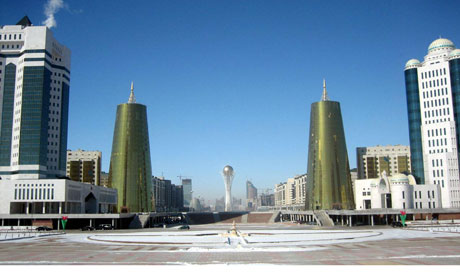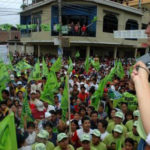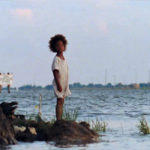An unfortunate example of petrodollars funding construction of monuments to strongmen and their corporate-multi-national enablers…


Space Station in the Steppes – Astana, Kazakhstan
“Astana, Kazakhstan: The Space Station in the Steppes,” By Rowan Moore. Published in The Observer, Guardian UK, Sun, 8 August 2010.
Called Astana, it is the world’s latest example of a rare but persistent type, the capital from built from nothing. It is in a line that includes St Petersburg, Washington DC, Canberra, Ankara and Brasilia and like them it provokes a question: can a city, in all its teeming complexity, really be planned? Or does the attempt lead only to a synthetic simulacrum, a kind-of city that is not quite the real thing?
What Kazakh President Nursultan Nazarbayev wanted he got, thanks partly to oil revenues from the distant Caspian Sea, which Nazarbayev claimed for Kazakhstan in a protracted haggle with Boris Yeltsin – closing the deal with the help of vodka and a map doodled on a napkin, which is now in the Museum of the First President of the Republic of Kazakhstan.
Like Persian Gulf cities, Astana floats on an exhalation of petrodollars. Like Gulf cities and new Chinese cities such as Shenzhen, Astana inspires wonder that it is there at all; but while having some buildings of eye-aching ugliness, it has a greater sense of order. At street level in Dubai all is congestion. Here it is trimmed hedges, well-behaved traffic, well-kept paving and a complete lack of litter, or of visible signs of prostitution, drug-taking or beggary. It most resembles the controlled cleanliness of Singapore.”













This is a wonderful post and may be one that should be followed up to see how things go
A comrade e mailed this link the other day and I am desperately looking your next write. Carry on on the high quality work.
Spotted your web blog via google the other day and absolutely like it. Keep up the good work.
I’m gonna bookmark this one for sure, thanks!
US$, Wars & Earthquakes
By Nalliah Thayabharan
At the end of WWII, an agreement was reached at the Bretton Woods Conference which pegged the value of gold at US$35 per ounce and that became the international standard against which currency was measured. But in 1971, US President Richard Nixon took the US$ off the gold standard and ever since the US$ has been the most important global monetary instrument, and only the US can print them. However, there were problems with this arrangement not least of all that the US$ was effectively worthless than before it reneged on the gold-standard. But more importantly because it was the world’s reserve currency, everybody was saving their surpluses in US$. To maintain the US$’s pre-eminence, the Richard Nixon administration impressed upon Saudi Arabia and therefore Organisation of Petroleum Exporting Countries(OPEC) to sell their oil only in US$. This did two things; it meant that oil sales supported the US$ and also allowed the USA access to exchange risk free oil. The USA propagates war to protect its oil supplies, but even more importantly, to safeguard the strength of the US$. The fear of the consequences of a weaker US$, particularly higher oil prices is seen as underlying and explaining many aspects of the US foreign policy, including the Iraq and Libyan War.
The reality is that the value of the US$ is determined by the fact that oil is sold in US$. If the denomination changes to another currency, such as the euro, many countries would sell US$and cause the banks to shift their reserves, as they would no longer need US$ to buy oil. This would thus weaken the US$ relative to the euro. A leading motive of the US in the Iraq war — perhaps the fundamental underlying motive, even more than the control of the oil itself — is an attempt to preserve the US$ as the leading oil trading currency. Since it is the USA that prints the US$, they control the flow of oil. Period. When oil is denominated in US$ through US state action and the US$ is the only fiat currency for trading in oil, an argument can be made that the USA essentially owns the world’s oil for free. Now over $1.3 trillion of newly printed US$ by US Federal Reserve is flooding into international commodity markets each year.
So long as almost three quarter of world trade is done in US$, the US$ is the currency which central banks accumulate as reserves. But central banks, whether China or Japan or Brazil or Russia, do not simply stack US$ in their vaults. Currencies have one advantage over gold. A central bank can use it to buy the state bonds of the issuer, the USA. Most countries around the world are forced to control trade deficits or face currency collapse. Not the USA. This is because of the US$ reserve currency role. And the underpinning of the reserve role is the petrodollar. Every nation needs to get US$ to import oil, some more than others. This means their trade targets US$ countries.
Because oil is an essential commodity for every nation, the Petrodollar system, which exists to the present, demands the buildup of huge trade surpluses in order to accumulate US$ surpluses. This is the case for every country but one — the USA which controls the US$ and prints it at will or fiat. Because today the majority of all international trade is done in US$, countries must go abroad to get the means of payment they cannot themselves issue. The entire global trade structure today works around this dynamic, from Russia to China, from Brazil to South Korea and Japan. Everyone aims to maximize US$ surpluses from their export trade.
Until November 2000, no OPEC country dared violate the US$ price rule. So long as the US$ was the strongest currency, there was little reason to as well. But November was when French and other Euroland members finally convinced Saddam Hussein to defy the USA by selling Iraq’s oil-for-food not in US$, ‘the enemy currency’ as Iraq named it, but only in euros. The euros were on deposit in a special UN account of the leading French bank, BNP Paribas. Radio Liberty of the US State Department ran a short wire on the news and the story was quickly hushed.
This little-noted Iraq move to defy the US$ in favor of the euro, in itself, was insignificant. Yet, if it were to spread, especially at a point the US$ was already weakening, it could create a panic selloff of US$ by foreign central banks and OPEC oil producers. In the months before the latest Iraq war, hints in this direction were heard from Russia, Iran, Indonesia and even Venezuela. An Iranian OPEC official, Javad Yarjani, delivered a detailed analysis of how OPEC at some future point might sell its oil to the EU for euros not US$. He spoke in April, 2002 in Oviedo Spain at the invitation of the EU. All indications are that the Iraq war was seized on as the easiest way to deliver a deadly pre-emptive warning to OPEC and others, not to flirt with abandoning the Petro-dollar system in favor of one based on the euro. The Iraq move was a declaration of war against the US$. As soon as it was clear that the UK and the US had taken Iraq, a great sigh of relief was heard in the UK Banks.
First Iraq and then Libya decided to challenge the petrodollar system and stop selling all their oil for US$, shortly before each country was attacked. The cost of war is not nearly as big as it is made out to be. The cost of not going to war would be horrendous for the US unless there were another way of protecting the US$’s world trade dominance. The US pays for the wars by printing US$ it is going to war to protect.
After considerable delay, Iran opened an oil bourse which does not accept US$. Many people fear that the move will give added reason for the USA to overthrow the Iranian regime as a means to close the bourse and revert Iran’s oil transaction currency to US$. In 2006 Venezuela indicated support of Iran’s decision to offer global oil trade in euro. In 2011 Russia begins selling its oil to China in rubles
6 months before the US moved into Iraq to take down Saddam Hussein, Iraq had made the move to accept Euros instead of US$ for oil, and this became a threat to the global dominance of the US$ as the reserve currency, and its dominion as the petrodollar.
Muammar Qaddafi made a similarly bold move: he initiated a movement to refuse the US$ and the euro, and called on Arab and African nations to use a new currency instead, the gold dinar. Muammar Qaddafi suggested establishing a united African continent, with its 200 million people using this single currency. The initiative was viewed negatively by the USA and the European Union (EU), with French president Nicolas Sarkozy calling Libya a threat to the financial security of mankind; but Muammar Qaddafi continued his push for the creation of a united Africa.
Muammar Gaddafi’s recent proposal to introduce a gold dinar for Africa revives the notion of an Islamic gold dinar floated in 2003 by Malaysian Prime Minister Mahathir Mohamad, as well as by some Islamist movements. The notion, which contravenes IMF rules and is designed to bypass them, has had trouble getting started. But today Iran, China, Russia, and India are stocking more and more gold rather than US$.
If Muammar Qaddafi were to succeed in creating an African Union backed by Libya’s currency and gold reserves, France, still the predominant economic power in most of its former Central African colonies, would be the chief loser. The plans to spark the Benghazi rebellion were initiated by French intelligence services in November 2010.
In February 2011, Dominique Strauss-Kahn, managing director of the International Monetary Fund (IMF), has called for a new world currency that would challenge the dominance of the US$ and protect against future financial instability. In May 2011 a 32 year old maid, Nafissatou Diallo, working at the Sofitel New York Hotel, alleges that Strauss-Kahn had sexually assaulted her after she entered his suite.
On Aug 18 2011, Venezuelan President Hugo Chavez announces a plan to pull Gold reserves from US and European Banks .Venezuela reportedly has the largest oil reserves in the world. Venezuelan President Hugo Chavez has been a strong proponent for tighter Latin America integration – which is a move away from the power of the US banking cartels.
Venezuelan President Hugo Chavez formed oil export agreements with Cuba, directly bypassing the Petrodollar System. Cuba was among those countries that were later added to the “Axis of Evil” by the USA. Venezuelan President Hugo Chavez has accused the US of using HAARP type weapons to create earthquakes.
On Aug 24, 2001 a 7 magnitude earthquake rocks Northern Peru bordering Venezuela which doesn’t use the Petrodollar system and Brazil which has been engaged in discussions to end US$ denominated oil transactions. Is it a coincidence that these uncommonly powerful earthquakes are occurring in historically uncommonly large numbers during such a short period of time?. And that they are occurring in or close to countries that have been seriously discussing plans to leave the Petrodollar system, or are already outside it?
HAARP stands for High Frequency Active Auroral Research Program. It is an ionospheric research program that is jointly funded by the US Air Force, the US Navy, the University of Alaska and the Defense Advanced Research Projects Agency. The HAARP program operates a major Arctic facility, known as the HAARP Research Station. It is located on an US Air Force owned site near Gakona, Alaska. HAARP has the ability to manipulate weather and produce earthquakes. It is capable of directing almost 4 Mega Watts of energy in the 3 to 10 MHz region of the HF band up into the ionosphere. This energy can be bounced off of the ionosphere and directed back down at the earth to create earthquakes. Patents have been applied for discussing such applications. HAARP could potentially be used by adversaries to produce such events.
HAARP based technology is being actively used to emit powerful radio waves that permeate the earth and subsequently cause strong enough oscillations along fault lines of targeted areas to produce earthquakes.
Thigh power radio waves of HAARP can be used to produce such intense vibrations as to cause an earthquake. HAARP based technology can be used to encourage/produce various weather phenomena such as hurricanes, flooding, or drought through manipulation of the ionosphere. Already Russia, China and Venezuela have suggested that a HAARP type technology weapon is capable of such and attack and been used against several countries causing severe destructions in Haiti, Japan, Russia, China, Iran, Chile, New Zealand, Afghanistan, India etc.
What would the probable response be to such an attack be? An armed conflict with the US? Or perhaps something more within reach and even more damaging at this point, the elimination of the Petrodollar system and a subsequent dumping of surplus US$ into the international and US financial markets resulting in the quick collapse of the US$. Attacking these countries with HAARP would destabilize their economies and currencies and to prevent a move away from the US$ and the Petrodollar system.